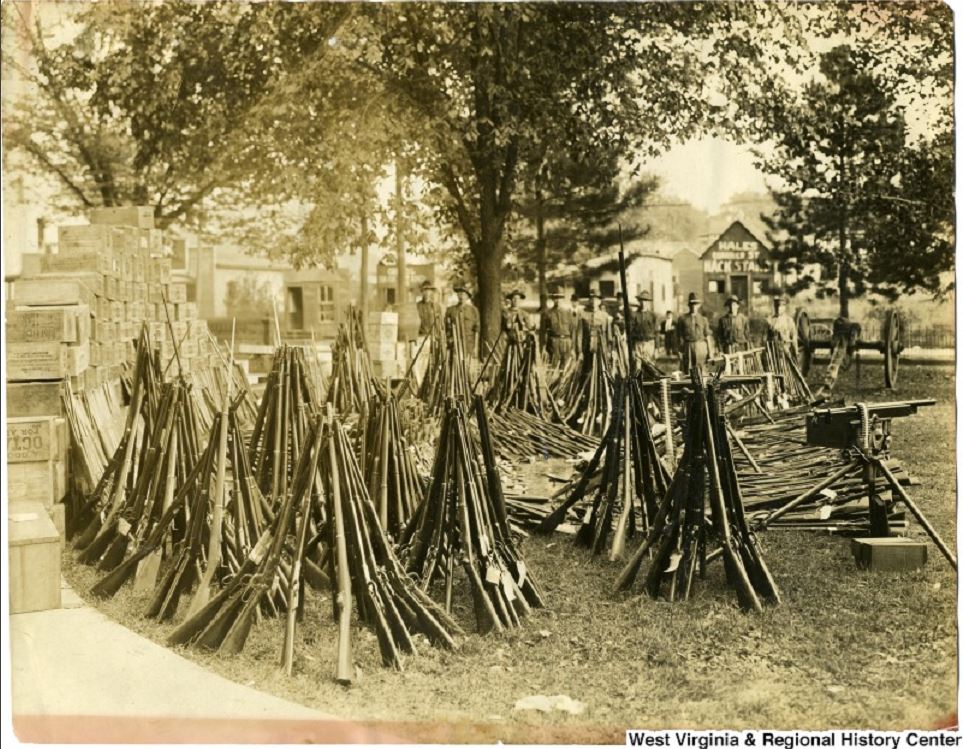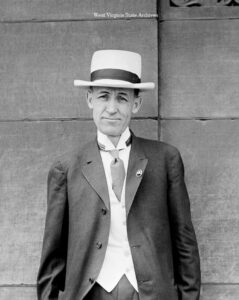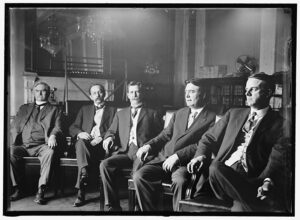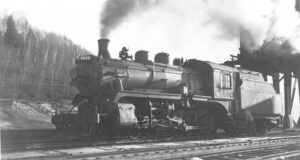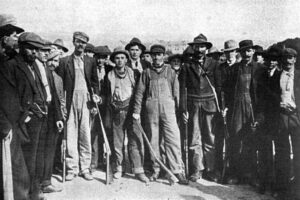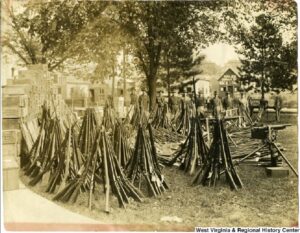Governor William E Glasscock had convened a commission to determine the cause of the labor dispute. The findings are now being released and everyone is holding their breath. Will the Commission rule be in favor of the strikers or in favor of the coal operators? Also, we have an uneasy peace in the Paint and Cabin Creek valley. The first martial law has been lifted and there has been no retaliation on either side so far. Until the battle for Paint-Cabin Creek begins to rage…
The Commission’s Findings
In November 1912, the Commission concluded their investigations and reported “we find that the operators are within their rights in declining to recognize a union which would place them in a helpless minority when joined to those of the four competitive states.” ~ (Wikipedia, Paint Creek–Cabin Creek strike of 1912) This was open criticism of the miner’s claims and the committee considered their grievances to be invalid. The miners had been dealt a devastating blow. Because of the mounting anger, Glasscock made a decision.
Martial law was re-imposed on November 15th and was lifted on January 10th by Governor Glasscock who had less than two months left in office.
The “Blue Moose Special”
February 7, 1913, the miners attacked Mucklow, West Virginia. There was at least one casualty. In retaliation, that night, coal operator Quinn Martin and Kanawha Sheriff Bonner Hill using a modified train called the “Blue Moose Special” which was armored with the sides reinforced with iron plating equipped with a machine gun. The men turned off the lights on the train and drove it to Holly Grove, a tent colony that the UMW had established for the miners and their families, and opened fire into the homes and tents. One death of a miner and one woman was injured by this action.
An Italian miner, Francis Francesco Estep, while trying to protect his pregnant wife was shot in the face and killed. Even though several miners had died before now, the murder of Estep inflamed the anger of the miners. What happened at Holly Grove made national headlines the next day. One store owner was so enraged by the news of the night raid that he sent ammo and guns to the miners to protect themselves and their families.
The Battle of Mucklow
Tempers had reached a boiling point when on February 10, 1913, the miners attacked armed Baldwin-Felts guards in what is was called Mucklow, West Virginia. There are estimates of between three thousand to one hundred thousand shots that were fired from the guard’s lever-action Winchesters, a Gatling gun, and the miner’s guns. When the smoke had cleared, and the gunshots no longer rang through the air, there were four guards and twelve strikers dead.
Third Martial Law
After the Battle of Mucklow, the third and final Martial law was called. In no other time in history did martial law take on the scale than it did during this time. There were almost 300 arrests of miners, including strike leaders and Mother Jones. These arrests led to military tribunals for murder and inciting violence against the coal operators and guards. Civil Courts were still in session but they were not used at that time. The guards and the coal operators did not face any charges against them for their actions in the Strike.
Mother Jones’ involvement with the strike would have her arrested on February 13, 1913. She was charged in a military court for inciting a riot by attempting to read the U.S. Constitution and conspiracy to commit murder.
She had attempted and succeeded to get a note to U. S. Senator John W. Kern and the editor of the Labor Argus, Charles H. Boswell who was sympathetic to the cause of the miners.
She refused to recognize the authority of the Court over her and refused to give a plea in her case. Jones was then sentenced to twenty years in the penitentiary. However, she developed pneumonia and was sent to Charleston, West Virginia for medical treatment. Then she was placed on house arrest in Pratt, West Virginia in Mrs. Carney’s Boarding House.
We will leave this with the arrest of almost 300 miners and Mother Jones and the third martial law well underway. In the next post, we will have the upcoming installation of a new Governor of the State of West Virginia. And how the Governor got involved with the Strike negotiations.
Source Information
United Mine Workers
https://en.wikipedia.org/wiki/United_Mine_Workers
Paint Creek–Cabin Creek strike of 1912
https://en.wikipedia.org/wiki/Paint_Creek%E2%80%93Cabin_Creek_strike_of_1912
West Virginia coal wars
https://en.wikipedia.org/wiki/West_Virginia_coal_wars
Paint Creek–Cabin Creek strike of 1912
https://infogalactic.com/info/Paint_Creek%E2%80%93Cabin_Creek_strike_of_1912
Mother Jones
https://en.wikipedia.org/wiki/Mother_Jones
Paint Creek and Cabin Creek Strikes
https://www.nps.gov/articles/000/paint-creek-and-cabin-creek-strikes.htm
Paint Creek-Cabin Creek Strike of 1912
https://paintschoices.blogspot.com/2017/02/paint-creek-cabin-creek-strike-of-1912_24.html
Mucklow / Gallagher, WV
https://www.hmdb.org/m.asp?m=137796#:~:text=The%20village%20of%20Mucklow%20was%20a%20hotbed%20of,had%20lever%20action%20Winchesters%20and%20a%20Gatling%20gun.
Eugene V. Debs in West Virginia, 1913:
A Reappraisal
By Roger Fagge
https://www.wvculture.org/history/journal_wvh/wvh52-1.html
Copyright and Other Information
All photos are in the public domain unless otherwise noted. This includes photos dated before 1923. All other photos are used with permission or under the education fair use statute of the US copyright law.
Copyright 2022 Kentucky Tennessee Living
kytnliving.com/copyright-2/
Social Media Pages
For more about us, you can visit our Facebook page:
https://www.facebook.com/kytnliving
Our Twitter page:
https://www.twitter.com/KYTNLiving
Our YouTube Channel:
https://www.youtube.com/kytnliving
When we forget our past and who we are as a people, then we become who “they” say we are. ~~ David Sergent
I have attended the University of Kentucky. I have an Associates Degree from Hazard Community College and Technical School. I have also attended the University of Pikeville. I have taken several classes in Journalism as well as in the Appalachian History, Literature, and Sociology during my time at those schools.
I was born in Florida and grew up in Burdine, Kentucky. I have been married to David W. Sergent since May 4, 2013. I have two children and four grandchildren from a previous marriage. I currently live in Tennessee but my hope is to one day come back home to live in the beautiful mountains once more.


